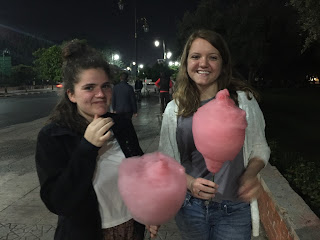 |
| Enjoying Sidi Bou Said |
It was time for a break from the red city, so we headed for our
North African neighbor, Tunisia, the country of white and blue. We left behind
the dust of Marrakech and found cool Mediterranean blues waiting for us on our
arrival in Tunis.
The vacation gods
were smiling on us as we breezed through customs, were handed a free SIM card
for our phones, and found a kind lady with a rental car waiting for us just
outside the airport. The hoops that we have gotten used to jumping
through when traveling around Morocco, seemed to have vanished into thin air.
We sighed and smiled a little at the prospect of finding a relaxed vibe on this
adventure.
After a few minor
bumps (like not having a map, having to wait through a small skirmish at the
telecom booth to load data onto our phone, and discovering that the door handle
in the car was hanging from a thread), we pointed the car in the direction of
Sidi Bou Said. An artists' hub in the
north of Tunis with a blue and white bohemian vibe, Sidi Bou overlooks a
perfect blue Mediterranean Sea. It’s white buildings glimmer in the sun. We
immediately embraced the laid-back spirit of the town. We reclined in a tea
room/shisha lounge for lunch before setting out to explore the quaint streets
and venture down the steep path to the marina. The views, sunshine, and hot
oily donuts we found on the street made for a perfect start to our vacation.
 |
| Waffles, bananas, and socks |
From Sidi Bou we
had every intention of heading to Carthage to tour the ruins. We were right
there after all, and it seemed like sacrilege to not make the effort. Alas, our
3:00 a.m. departure from Marrakech was catching up with us. After a few wrong
turns, the discovery that the ruins are spread out among various sites, and an
overall apathy on the part of all, we decided to skip the historical tour and
head for our hotel on the beach. We found our way to the highway and
watched the Tunisian countryside speed by as we headed south to Mahdia.
 |
| Poppies! |
The red and pink
towns of Morocco with their angular mosques had given way to small white
villages with ornate, rounded minarets (often decorated with tile) pointing to
the sky. Olive trees still dominated the landscape. It was flat as far as our
eyes could see. There were fewer donkeys but lots and lots of sheep. Camels
munched grass by the road (and sadly their necks and heads hung from hooks in
the butcher shops too). It all felt familiar yet different at the same time.
Mahdia turned out
to be a small seaside community with a strip of tourist hotels in different
states of repair and disrepair. We enjoyed beautiful views from our room of a
sparkling (but glacial) pool. The ocean waves lapped at the beach, but the
water was too cold for swimming. We bundled up and enjoyed the sun and
occasionally stripped down to bathing suits for a few minutes just to remind
our pasty skin what the sun felt like. Our limbs very rarely see the light of
day in Morocco, so we took advantage of the more relaxed attitude toward
visible flesh at the hotel.
 |
| Mahdia Moments |
 |
| Ooooh! This is what I need! |
Mahdia's medina
was quiet and residential. We explored the shoreline, spied on fishermen, and
climbed on rocks. Twice we ventured out to see a little slice of Tunisia. The
Roman Amphitheatre at El Djem was a highlight. Second in size only to the Roman
Colosseum, the Amphitheatre is well-preserved, and it was completely empty the
day we visited (which may have had something to do with the pouring rain).
We staged our own imaginary gladiator games among the ruins.
Kairouan, a city
known as a center for Islamic scholarship, was on my list of places to visit.
Kairouan's Great Mosque is considered to be one of the most important monuments
of Islamic civilization. Making seven pilgrimages to this mosque is said to be
the equivalent of making one pilgrimage to Mecca. However, since we cannot go
inside of mosques, Kairouan's highlight for me was a visit to Bir Barouta,
where an unlucky camel spends his days attached to a pulley system that runs a
water wheel - drawing holy water from a well below that, according to legend,
is connected by an underground channel to the Zemzem spring in Mecca.
 |
| The magic camel |
 |
| The Mosque of Three Doors |
Fresh air, dirt
roads (occasionally lost), ocean breeze, too many games of hotel pool, bright
red poppies carpeting olive orchards, and blue and white buildings will be my
memories of Tunisia. A break from the constant hum of Marrakech was most
welcome. When we returned to Marrakech late at night, I prepared myself to
shift back into Moroccan mode. Then, we found ourselves whisked from the
airport back to our apartment by a friendly taxi driver without the slightest
squabble over the fare, and I smiled. The vacation gods were still smiling on
us and transitioning us back gently. We were home.
















































